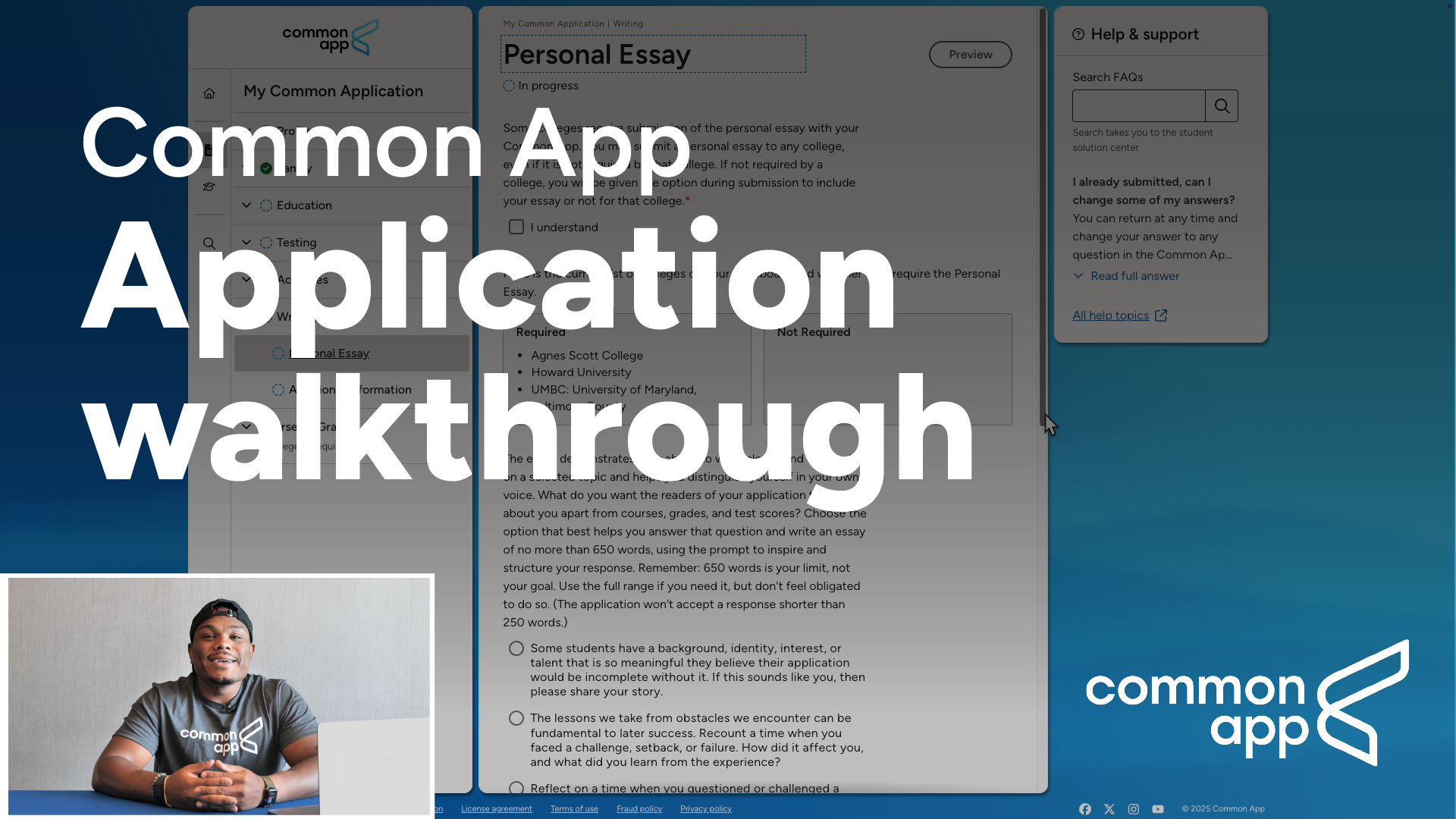Application guide for first-year students
Get tips and best practices to give yourself the best chance at success.

Application guide for first-year students
Get tips and best practices to give yourself the best chance at success.
What is Common App?
Get ready to begin your journey
Walk through the application with us before you apply.
Filling out your application takes time.
In the Education section, you will enter your high school grades and current courses. Some colleges also need you to self-report your high school transcript. You can check out your Courses & Grades section to learn more.
You can share your interests and who you are outside of the classroom in the activities section. You can share information about things like work, hobbies, clubs, and community engagement. And don't forget, other responsibilities and circumstances can also be important to share. This is the place to show colleges what makes you unique!
You may self-report scores for standardized tests you've taken in the Testing section. Every college has different testing requirements. Some colleges will always need your test scores. Other colleges may be flexible or have a test optional policy. Be sure to check the Testing policy of the colleges on your list.
Many colleges collect this information in the Family section for demographic purposes. We will ask for your parents' occupation, employment status, and education level. If applicable, we will also ask which college(s) they attended and how many degrees they have earned.
The Activities section isn't the only place to show your passion and where you excel! You will also have the chance to share any academic honors or achievements from high school.
Creating a Common App account is easy and should only take a few minutes.
Account rollover
Common App accounts can roll over from year to year!
With account rollover, you can start exploring Common App and save answers to questions in My Common Application at any time.
Once you’ve created your account and explored the colleges that accept the Common App, you're ready to start adding colleges.
A request to the college to remove the application fee. Using either the Common App fee waiver, which your counselor must confirm, or a college-specific fee waiver, you will not be required to pay the fee to submit your application.
Coed is a term used to describe a college or university that offers the integrated education of male and female students in the same environment.
All colleges need things like official school forms. Many colleges will also ask for letters of recommendation.
Counselors share their perspective using the context of the entire graduating class. They also submit the School Report and transcripts.
Parents will only need to submit a form if you apply using a college's early decision deadline. They will fill out part of your early decision agreement.
Teachers give a firsthand account of your intellectual curiosity and creative thought.
Other recommenders are usually non academic recommenders like coaches, employers, and peers. They give insight into your interests and activities outside of the classroom.
Advisors do not submit any forms. They track and check in on your application progress.
Every college gets to choose their own recommendation requirements. You can find more details on each college's information page.
It's important to stay organized as you work on your applications.
Each college's Explore Colleges profile provides lots of information about the college. You can find details on application information, campus culture, scheduling visits, and more.
In My Colleges or College search, you can learn more by viewing a school's college information page. Here, you can find the requirements for testing, writing, deadlines, and more.
The requirements grid is a comprehensive PDF that lists all the colleges that use the Common App and their requirements. You can also find the grid within the application.
We maintain a list of all Common App colleges and their essay prompts. This resource will help as you begin planning your essays. For more help on planning essays, check out our essay planning worksheet.
Account rollover
You can save answers to My Common Application questions year over year.
Get started on tasks like your personal essay or the activities section at any time.
Your answers to questions in My Common Application are saved year over year. Only get started on things like college-specific questions, writing supplements, or portfolios if you intend to apply this school year. For more info, check out our account rollover FAQ.
Sometimes writings essays can feel like the biggest part of your application. With a little bit of planning, organizing, and drafting, we can help you make this task more manageable.
Colleges can either make the personal essay optional or required. In the writing section of My Common Application, you will see a table that lists each college's requirements.
Many colleges include short answer questions or essay prompts within this section. You can find specific information about each college's individual writing prompts here.
Some colleges use a separate writing supplement. Not all colleges have a writing supplement. Some colleges only request this supplement based on your answers to other questions. You can find more information about writing supplements in My Colleges.

